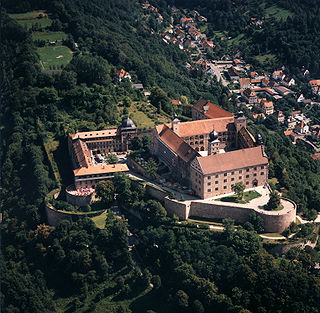
Plassenburg is a castle in the city of Kulmbach in Bavaria. It is one of the most impressive castles in Germany and a symbol of the city. It was first mentioned in 1135. The Plassenberg family were ministerial of the counts of Andechs and used as their seat the Plassenburg. The House of Guttenberg, a prominent Franconian noble family, traces its origins back to 1149 with a Gundeloh v. Blassenberg (Plassenberg). The name Guttenberg is derived from Guttenberg and was adopted by a Heinrich von Blassenberg around 1310. From 1340, the Hohenzollerns governed from Plassenburg castle their territories in Franconia till 1604. The Plassenburg was fortress and residence for the Hohenzollerns.

Treuchtlingen is a town in the Weißenburg-Gunzenhausen district, in Bavaria, Germany. It has a population of around 12,000.
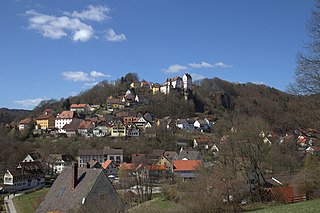
Egloffstein Castle is a former high mediaeval, aristocratic castle, that stands immediately west of the eponymous village of Egloffstein in the Upper Franconian county of Forchheim in the German state of Bavaria.

The ruins of Thüngfelderstein Castle, also called Eberhardstein Castle, are the burgstall of a demolished hill castle on a block of rock near Morschreuth in the south German state of Bavaria. The site lies within the market municipality of Gößweinstein in the county of Forchheim.
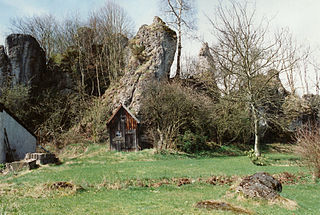
The burgstall or site of Bieberbach Castle is a ruined mediaeval spur castle at a elevation of 530 m above sea level (NN) on a rock formation in the southern part of the parish of Bieberbach, in the market municipality of Egloffstein in the county of Forchheim in the German state of Bavaria.
Dietzhof Castle was a high medieval water castle on the site of House No. 42 in the village of Dietzhof, in the municipality of Leutenbach in the county of Forchheim in the south German state of Bavaria.
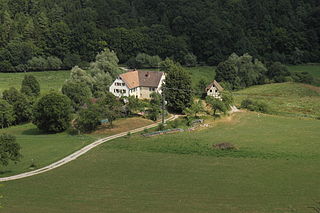
The burgstall of Dörnhof Castle is the site of a demolished, medieval lowland castle situated at a height of 400 m above sea level (NHN) in the vicinity of Dörnhof Farm near the village of Dörnhof, part of Gräfenberg in the county of Forchheim in the German state of Bavaria.
Gräfenberg Castle is the older of two former castles in Gräfenberg in the Upper Franconian county of Forchheim in the south German state of Bavaria. Today, there is little left of the castle; it is classed as a burgstall and the site is in the area of Bahnhofstraße 11 to 21. The castle was first recorded in the year 1477; its last remains were removed from about 1563.
Moschendorf Castle is a levelled mediaeval hill castle at a height of 400 m above sea level (NHN) about 50 metres east of the village of Moschendorf, in the market municipality of Gößweinstein in the Franconian county of Forchheim in the south German state of Bavaria.
The Altenburg fortification near Heroldsbach is a levelled early medieval fortified position at a height of 362 m above sea level (NHN), about 850 metres northwest of the church in Heroldsbach in the Upper Franconian county of Forchheim in the south German state of Bavaria. No historical or archaeological information is available for this sector fortification, but pottery finds from the interior of the site date to the Early Middle Ages. All that has survived is a double rampart system with a ditch. The site is protected by the state of Bavaria as monument number D-4-6331-0001: Frühmittelalterliche Abschnittsbefestigung "Altenburg".
Burk Castle is a levelled medieval motte and bailey castle in the area known as Beim Schanzbach, about 550 metres south-southwest of the church in Burk, a village in the borough of Forchheim in the county of Forchheim in the south German state of Bavaria.
Niedermirsberg Castle, also called the Steinhaus, is a levelled motte castle which is situated 780 metres west of the village church of Niedermirsberg, in the borough of Ebermannstadt in the county of Forchheim in the south German state of Bavaria.
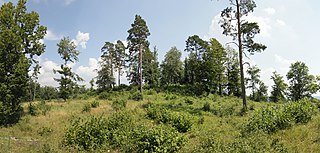
Ebermannstadt Castle is a levelled medieval motte castle on the heights of the Franconian Jura at Wacht Knock, west of the town of Ebermannstadt in the county of Forchheim in the south German state of Bavaria. It is one of the mightiest motte and bailey castles.

Rüssenbach Castle is a levelled water castle situated at a height of 310 m above sea level (NHN) on the northern edge of Rüssenbach, a village in the market borough of Ebermannstadt in the county of Forchheim in the south German state of Bavaria. It was built as a motte castle
The field fortification of Tiefenstürmig is a levelled, probably prehistorical, sector fortification at a height of 517 m above sea level (NHN) in the area known as Heiligkreuzholz about 600 metres east of the village centre of Tiefenstürmig, in the market municipality of Eggolsheim in the county of Forchheim in the south German state of Bavaria.
The burgstall of Wartleiten Castle is the site of a levelled, medieval hill castle situated at a height of 410 m above sea level (NHN) on the Wartleitenberg, about 600 metres southeast of the church in Streitberg, a village in the market municipality of Wiesenttal in the county of Forchheim in the south German state of Bavaria.
The burgstall of Unterailsfeld Castle is the site of a medieval lowland castle situated at a height of 360 m above sea level (NHN) in the village of Unterailsfeld, in the market municipality of Gößweinstein in the county of Forchheim in the south German state of Bavaria.
Forchheim Fortress was laid out after the occupation of the town of Forchheim during the Second Margrave War (1552) by the Bishopric of Bamberg. Today about one third of the fortification works have survived and have been incorporated into the municipal parks.

Schloss Kunreuth is situated on the northwestern edge of the eponymous village of Kunreuth which is part of the collective municipality of Gosberg in the county of Forchheim, in the province of Upper Franconia in the south German state of Bavaria.
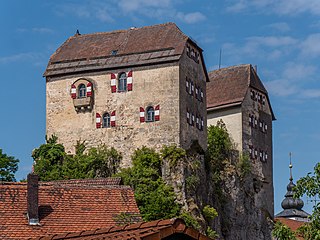
Hiltpoltstein Castle was originally a high mediaeval aristocratic castle dating to the 11th or 12th century. It stands in the centre of the market village of Markt Hiltpoltstein in the Upper Franconian county of Forchheim in the south German state of Bavaria. Its present appearance as a triple-winged building goes back to renovations carried out at the end of the 16th century.












